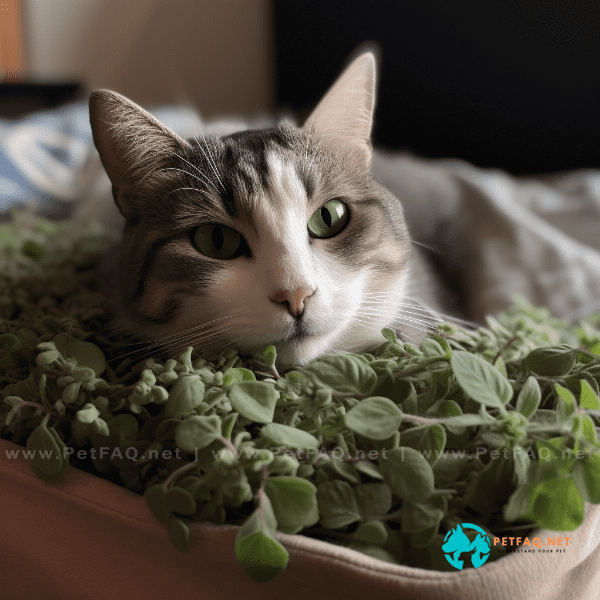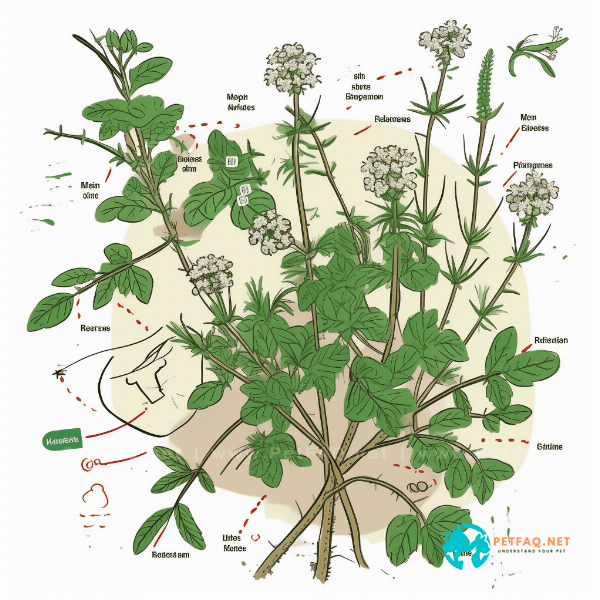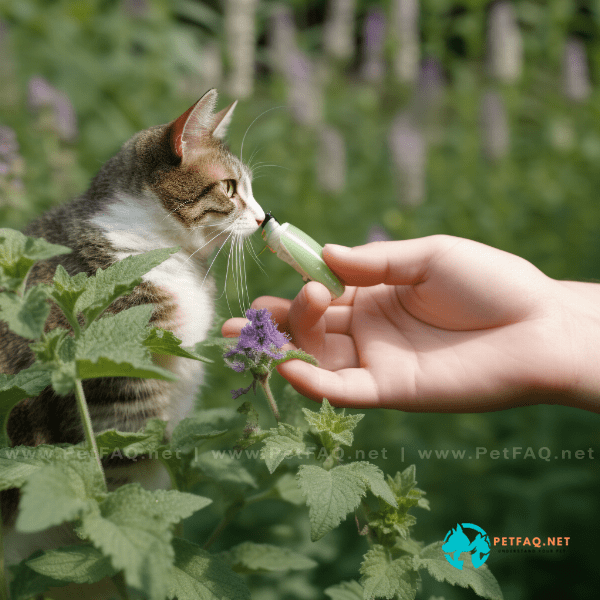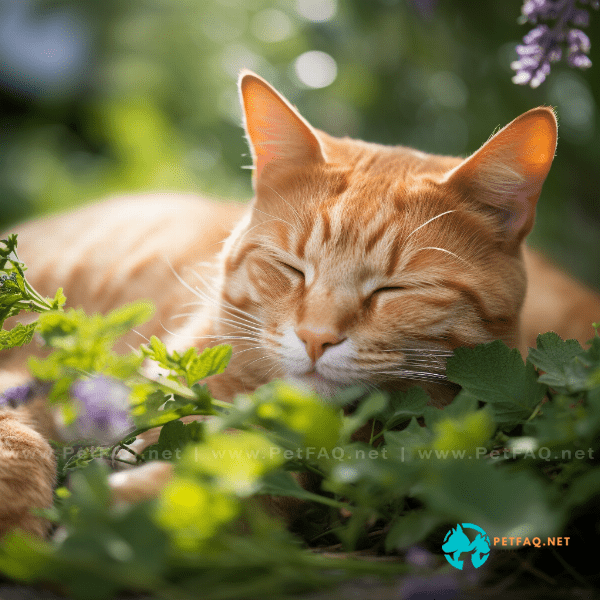Table of Contents
- What is Catnip and How Does it Work?
- The Historical Uses of Catnip in Medicine
- The Chemical Components of Catnip and Their Effects on the Body
- Catnip as a Natural Remedy for Anxiety and Insomnia
- The Anti-inflammatory Properties of Catnip and its Potential for Pain Relief
- How Catnip Can Help with Digestive Issues
- Catnip’s Ability to Repel Insects and Soothe Skin Irritations
- How to Prepare Catnip for Medicinal Use
- Dosage and Safety Considerations When Using Catnip as a Medicine
- Conclusion: Catnip’s Versatility and Promising Medicinal Potential
What is Catnip and How Does it Work?
Catnip (Nepeta cataria) is a perennial herb that belongs to the mint family. It is native to Europe and Asia, but it is now widely distributed throughout the world. Catnip is commonly known for its euphoric effects on cats. When cats come into contact with catnip, they often exhibit a range of playful and curious behaviors, such as rolling around, rubbing their faces and bodies on it, and even eating it.
The active ingredient in catnip is nepetalactone, which is found in the plant’s leaves and stems. Nepetalactone is a type of terpene that is known to affect the behavior of cats and insects. When cats inhale or ingest nepetalactone, it binds to receptors in their brains, triggering a range of neurological effects. These effects include increased activity, euphoria, and relaxation.
Although catnip is most well-known for its effects on cats, it has also been used for centuries for its medicinal properties. In traditional medicine, catnip was used to treat a variety of ailments, such as headaches, colds, and fevers. It was also used as a sedative and as a digestive aid.
Catnip’s medicinal properties are due to its ability to interact with the body’s endocannabinoid system (ECS). The ECS is a complex network of receptors and signaling molecules that are involved in regulating many physiological processes, such as pain sensation, inflammation, and immune function. Nepetalactone has been shown to interact with the ECS by activating CB1 and CB2 receptors, which are involved in modulating pain and inflammation.
In addition to its effects on the ECS, catnip also contains other compounds that have antimicrobial, antioxidant, and anti-inflammatory properties. For example, catnip contains rosmarinic acid, which has been shown to have anti-inflammatory and analgesic effects. This makes catnip a promising natural remedy for a variety of conditions, such as anxiety, insomnia, pain, and digestive issues.
Overall, catnip is a versatile herb that has a long history of use in traditional medicine. Its effects on the ECS and other physiological processes make it a promising natural remedy for a variety of health conditions. In the following sections of this blog post, we will explore some of the specific medicinal uses of catnip in more detail.

The Historical Uses of Catnip in Medicine
The historical uses of catnip in medicine can be traced back to ancient times. Catnip was used by the ancient Greeks, Romans, and Egyptians for its medicinal properties. In the Middle Ages, it was commonly used in Europe as a remedy for a range of ailments, such as nervousness, headaches, and colds.
One of the most well-known uses of catnip in traditional medicine is as a sedative. In the 16th century, herbalist John Gerard recommended catnip as a remedy for insomnia and restlessness. It was also commonly used as a calming agent for children and infants.
Catnip was also used as a digestive aid. The herb was believed to stimulate the digestive system and relieve gas and bloating. In traditional Chinese medicine, catnip was used to treat gastrointestinal disorders, such as diarrhea and colic.
Another historical use of catnip was for its fever-reducing properties. In the 19th century, American Eclectic physicians used catnip tea to treat fevers, colds, and flu. The herb was believed to induce sweating, which was thought to help reduce fever and rid the body of toxins.
Catnip was also used as a pain reliever. In traditional medicine, catnip was applied topically to painful areas to help reduce inflammation and relieve pain. It was also used as a remedy for menstrual cramps.
Overall, the historical uses of catnip in medicine are diverse and widespread. The herb has been used for centuries as a sedative, digestive aid, fever-reducer, and pain reliever. Today, modern research is exploring these traditional uses of catnip and uncovering its potential as a natural remedy for a variety of health conditions.

The Chemical Components of Catnip and Their Effects on the Body
Catnip contains a variety of chemical components that are responsible for its medicinal properties. The primary active ingredient in catnip is nepetalactone, a terpene that is found in the plant’s leaves and stems. Nepetalactone is known to interact with the body’s endocannabinoid system (ECS), which plays a key role in regulating pain sensation, inflammation, and immune function.
When nepetalactone interacts with the ECS, it activates CB1 and CB2 receptors, which are involved in modulating pain and inflammation. This makes catnip a promising natural remedy for conditions such as chronic pain, inflammation, and autoimmune disorders.
Catnip also contains other compounds that have medicinal properties. For example, catnip contains rosmarinic acid, which has been shown to have anti-inflammatory and analgesic effects. Rosmarinic acid also has antioxidant properties, which may help protect the body against oxidative stress and prevent damage to cells and tissues.
In addition, catnip contains a variety of essential oils, such as citronellol, geraniol, and thymol. These essential oils have antimicrobial properties, which may help prevent the growth of harmful bacteria and fungi. This makes catnip a potential natural remedy for conditions such as acne, fungal infections, and other skin conditions.
Furthermore, catnip contains tannins, which are compounds that have astringent properties. Astringents help to tighten and tone tissues, which may help reduce inflammation and swelling. This makes catnip a potential natural remedy for conditions such as hemorrhoids and varicose veins.
Overall, the chemical components of catnip have a variety of effects on the body. Nepetalactone interacts with the ECS to modulate pain and inflammation, while rosmarinic acid has anti-inflammatory and antioxidant properties. The essential oils in catnip have antimicrobial properties, and the tannins have astringent properties. These diverse chemical components make catnip a promising natural remedy for a variety of health conditions.

Catnip as a Natural Remedy for Anxiety and Insomnia
One study published in the Journal of Ethnopharmacology found that catnip had anxiolytic effects in mice. The study found that nepetalactone, the primary active ingredient in catnip, was responsible for these effects. Nepetalactone was shown to reduce anxiety-like behaviors in mice, indicating that it may have similar effects in humans.
In addition, catnip has been shown to have sedative effects in humans. A study published in the Journal of Herbal Pharmacotherapy found that participants who took a catnip extract experienced a significant reduction in anxiety and improved sleep quality compared to a placebo group. The study also found that the catnip extract was well tolerated and did not cause any adverse effects.

The Anti-inflammatory Properties of Catnip and its Potential for Pain Relief
One study published in the Journal of Natural Products found that nepetalactone, the primary active ingredient in catnip, exhibited anti-inflammatory effects in vitro. The study found that nepetalactone inhibited the production of inflammatory mediators such as nitric oxide and cytokines. This indicates that catnip may have potential as a natural remedy for conditions such as arthritis, which are characterized by chronic inflammation.
In addition, catnip has been shown to have analgesic properties in animal studies. A study published in the Journal of Medicinal Food found that a catnip extract reduced pain sensitivity in mice. The study concluded that catnip may be a useful natural remedy for pain relief.

How Catnip Can Help with Digestive Issues
One study published in the Journal of Ethnopharmacology found that catnip had gastroprotective effects in rats. The study found that catnip helped to protect the stomach lining from damage caused by ethanol, which is known to cause gastric ulcers. This indicates that catnip may have potential as a natural remedy for conditions such as gastritis and peptic ulcers.
In addition, catnip has been shown to have carminative properties in animal studies. Carminatives are substances that help to relieve gas and bloating in the digestive system. A study published in the Journal of Agricultural and Food Chemistry found that a catnip extract exhibited carminative activity in rats. This indicates that catnip may be a useful natural remedy for conditions such as flatulence and indigestion.

Catnip’s Ability to Repel Insects and Soothe Skin Irritations
Catnip has been traditionally used as a natural insect repellent and for soothing skin irritations. The herb’s insect-repellent and skin-soothing properties have been well documented in traditional medicine, and modern research is beginning to explore its potential as a natural remedy for insect bites and skin irritations.
One study published in the Journal of Agricultural and Food Chemistry found that nepetalactone, the primary active ingredient in catnip, exhibited strong insect-repelling properties. The study found that nepetalactone was effective at repelling mosquitoes, flies, and cockroaches. This indicates that catnip may have potential as a natural insect repellent.
In addition, catnip has been shown to have anti-inflammatory and antihistamine properties in animal studies. This makes it a potentially useful natural remedy for soothing skin irritations caused by insect bites, rashes, and other skin conditions. A study published in the Journal of Agricultural and Food Chemistry found that a catnip extract exhibited anti-inflammatory and antihistamine activity in rats. The study concluded that catnip may be a useful natural remedy for conditions such as eczema, psoriasis, and insect bites.
Moreover, catnip has been traditionally used as a natural remedy for acne. A study published in the Journal of Herbal Pharmacotherapy found that a catnip extract exhibited antibacterial activity against the bacteria that cause acne. The study concluded that catnip may be a useful natural remedy for acne treatment.
It is worth noting that while catnip may be useful as a natural remedy for insect bites and skin irritations, it should not be used as a substitute for professional medical advice. If you are experiencing skin irritations or insect bites, it is important to speak with a healthcare professional to determine the underlying cause and develop an appropriate treatment plan.

How to Prepare Catnip for Medicinal Use
If you’re interested in using catnip for its medicinal properties, it’s important to know how to prepare it properly. Here are some ways to prepare Catnip for Medicinal use:
1. Catnip Tea: One of the easiest ways to use catnip is by making tea. Simply steep 1-2 teaspoons of dried catnip leaves or flowers in hot water for 10-15 minutes. You can sweeten the tea with honey or add a slice of lemon if desired. Catnip tea can be used for its relaxing, digestive, and anti-inflammatory properties.
2. Catnip Tincture: A tincture is a concentrated liquid extract that can be used for a variety of medicinal purposes. To make a catnip tincture, fill a jar with dried catnip leaves or flowers and cover with a high-proof alcohol such as vodka or brandy. Let the mixture sit for 4-6 weeks, shaking the jar daily. Strain the liquid and store in a dark, cool place. Catnip tincture can be used for its relaxing, digestive, and pain-relieving properties.
3. Catnip Poultice: A poultice is a paste made from crushed herbs that can be applied directly to the skin for its anti-inflammatory and soothing properties. To make a catnip poultice, crush fresh or dried catnip leaves and mix with a small amount of water to form a paste. Apply the paste directly to the affected area and cover with a clean cloth. Leave the poultice on for 10-15 minutes before removing. Catnip poultice can be used for insect bites, rashes, and other skin irritations.
4. Catnip Essential Oil: Essential oils are highly concentrated plant extracts that can be used for their therapeutic properties. To make catnip essential oil, steam-distill the leaves and flowers of the plant. Catnip essential oil can be used for its insect-repelling, relaxing, and pain-relieving properties.
It’s important to note that while catnip is generally safe for most people, it’s always a good idea to consult with a healthcare professional before using it for medicinal purposes. Pregnant or breastfeeding women, children, and people with certain medical conditions may need to avoid using catnip. Additionally, make sure to use high-quality catnip from a reputable source to ensure safety and efficacy.

Dosage and Safety Considerations When Using Catnip as a Medicine
While catnip is generally considered safe for most people when used in moderation, there are some dosage and safety considerations to keep in mind when using it as a medicine. Here are some important factors to consider:
1. Dosage: The appropriate dosage of catnip can vary depending on the individual and the specific condition being treated. As a general rule, it’s recommended to start with a low dose and gradually increase as needed. For example, when making catnip tea, start with 1-2 teaspoons of dried leaves or flowers per cup of water and gradually increase as needed. When using a tincture, follow the manufacturer’s instructions or consult with a healthcare professional for guidance.
2. Potential Side Effects: While catnip is generally considered safe, some people may experience side effects such as dizziness, headaches, or nausea. These side effects are typically mild and go away on their own, but if you experience severe or persistent symptoms, stop using catnip and consult with a healthcare professional.
3. Interactions with Medications: Catnip may interact with certain medications, including sedatives, blood thinners, and diuretics. If you’re taking any medications, be sure to consult with a healthcare professional before using catnip as a medicine.
4. Safety for Children and Pregnant Women: While catnip is generally safe for most people, it’s not recommended for children under the age of two or for pregnant or breastfeeding women. Additionally, people with certain medical conditions such as liver or kidney disease should avoid using catnip.
5. Quality and Source: When using catnip as a medicine, it’s important to use high-quality catnip from a reputable source. Look for organic catnip that has been harvested and processed using safe and sustainable methods.
In summary, catnip can be a safe and effective natural remedy for a variety of health conditions when used properly. However, it’s important to keep these dosage and safety considerations in mind and to consult with a healthcare professional before using catnip as a medicine.

Conclusion: Catnip’s Versatility and Promising Medicinal Potential
Catnip is a versatile herb that has been used for centuries for its medicinal properties. From its calming effects on the mind and body to its ability to soothe skin irritations and repel insects, catnip offers a wide range of health benefits that make it a promising natural remedy.
The historical use of catnip in medicine and its chemical components have demonstrated its potential to treat various ailments such as anxiety, insomnia, pain, digestive issues, and more. Additionally, its anti-inflammatory and analgesic properties have shown promising results in reducing pain and inflammation.
While more research is needed to fully understand the medicinal potential of catnip, its versatility and safety make it an attractive option for those seeking natural remedies. With its ability to be prepared in various forms, such as tea, tincture, or essential oil, catnip is a convenient and accessible herb for anyone looking to benefit from its medicinal properties.
However, it’s important to keep in mind the dosage and safety considerations when using catnip as a medicine. As with any natural remedy, it’s always a good idea to consult with a healthcare professional before using catnip, especially if you are taking medication or have any underlying medical conditions.
In conclusion, catnip’s versatility and promising medicinal potential make it an herb worth exploring for those seeking natural remedies for various health conditions. Its long history of use and its continued popularity today speak to its effectiveness and accessibility. With proper dosage and use, catnip can be a safe and effective natural remedy for a wide range of health concerns.

Frequently Asked Questions (FAQs) about Catnip and medicinal uses:
1. Can catnip be used to relieve symptoms of the common cold?2. How does catnip help with anxiety and stress?
3. Can catnip be used to treat insomnia?
4. How does catnip affect the digestive system?
5. Is catnip effective in treating menstrual cramps?



